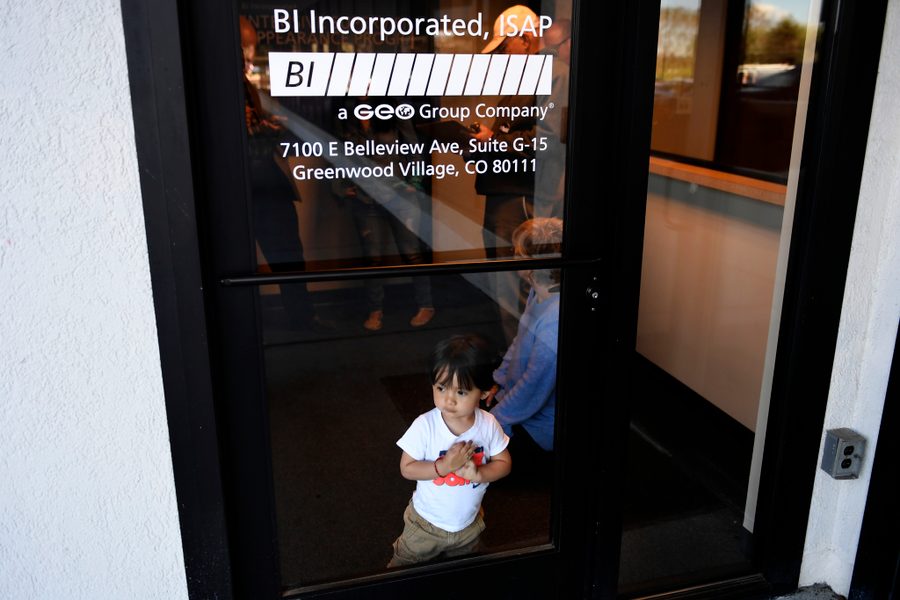Electronic Monitors: How Companies Dream of Locking Us in Our Homes
These are the corporations profiting from e-carceration.
James Kilgore

Despite the law-and-order offensive of President Donald Trump and Attorney General Jeff Sessions, the momentum for decarceration and ending cash bail continues to grow. This is cause for optimism. However, decarceration may not ultimately mean freedom. In many cases, welcoming arms are waiting for those coming out of prison gates, ready to strap plastic GPS shackles around their ankles. The number of electronic monitoring (EM) devices in the United States has more than doubled in the past decade. This means decarceration may presage a massive shift of the costs of incarceration onto families and communities, and the transformation of the nation’s correctional system from public control to private companies. Activist Rebecca Brown, the director of Reentry Solutions Group and a keen analyst of monitoring, told In These Times, “Rather than advancing a more equitable and effective criminal justice system, electronic monitoring’s enormous and unchecked capacities transform entire communities into open-air jails, intentionally depriving a whole class of people of liberty and privacy even as its efficacy, necessity and appropriateness go entirely unchallenged.” Welcome to the era of e-carceration, and carceral conglomerates.
Let’s track that little canary with a couple of examples. State authorities in Ohio are implementing Targeted Community Alternatives to Prison (T-CAP) to reduce prison populations. But these people will not be “free.” T-Cap will force people with low-level felonies to do their time in county jails or be fitted with EM devices. In other states, the use of EM during parole is mushrooming. In New York, according to a Freedom of Information Act query, the number of electronically monitored people on parole has increased more than 2.5 times since 2010.
The law-and-order agenda of the Trump-Sessions regime also has EM spinoffs, with overflow populations from immigrant detention centers increasingly being placed on what Spanish-speakers refer to as the “grillete” (shackle). A parallel process has occurred in juvenile justice where, according to a 2017 report by UC Berkeley’s Samuelson Law Clinic and East Bay Community Law Center, “one of the most significant changes in the juvenile justice system in recent decades has been the proliferation of electronic monitoring of youth.”
Private sector companies are the main providers of EM devices and monitoring technology. Critics of mass-incarceration are familiar with the (often overblown) threats of private prisons. If we trace the growth of EM back to the companies that sell, maintain and surveille those ankle shackles, we discover the growth of a new parallel correctional system that has been quietly building over the last decade. A recent report by the Urban Justice Center and Corrections Accountability Project provides useful data to outline this process. While the scale of state operations in the prison industrial complex still dwarfs the profile of private operators, carceral conglomerates are reaching into new areas, delivering new products and “services.” These companies’ activities not only crowd out state entities at times, but also further insert profit-driven practices into a public-sector ethos already largely dominated by neoliberal values.
Carceral Conglomerates
BI Incorporated and Securus Technologies are the two largest providers of electronic monitoring devices in the United States. With long histories of unethical profiteering and abuse of criminalized populations, both have also been the targets of considerable protest and litigation.
While pressure for reform has grown, there’s also been a sea change in the opportunities presented to these firms to raid and privatize the services of public corrections. With new friends on Capitol Hill and in the White House, firms like BI and Securus are pulling pieces out of the very heart of the public prison-industrial complex and reshaping them for private profit. And they’re making it sound like an exercise in humanism: carceral humanism, that is.
BI Incorporated
Founded in 1978, Colorado-based BI Incorporated is likely the largest operator in the EM sector, controlling about 30 percent of the nation’s monitoring devices, according to the company. In 2011, BI was bought out by GEO Group, the world’s largest private prison operator. Under the banner, “We believe that every human being should be treated with dignity and that his or her basic human rights should be respected and preserved at all times,” the GEO Group’s largest division, GEO Corrections, runs 141 prisons, detention centers and “community reentry facilities” holding up to 96,000 people, including its international operations in the United Kingdom, Australia and South Africa. The GEO Group is also a prime mover in finding new ways to monetize corrections. In 2013 it secured Real Estate Investment Trust (REIT) status, which grants companies the ability to write off taxes on income that comes from rentals, if 75 percent or more of their revenue comes from rent. The GEO Group claims that payments from government entities to keep people behind bars constitute rental income and therefore are tax exempt.
Within the GEO Group, BI is housed in the Orwellian GEO Care division. Creating a sugary-sweet “caring” unit has also opened up new markets and product opportunities for the GEO Group beyond EM. The GEO Group promotes a “continuum of care” through which it offers classes, treatment and workshops inside prisons, as well as transition houses, electronic monitoring and day-reporting centers for those who leave prison — a wraparound carceral service. This program received the annual “Innovation in Corrections Award of the American Correctional Association” in 2018 for its work at Graceville Correctional Facility in Florida. Another key component of the continuum is the GEO Group’s 2014 opening of a gender responsive prison for women in McFarland, California. The BI website offers a link to GEO Reentry services, which provide potential clients with workshops and courses wholesomely packaged as “evidence-based programming.”
As a company, BI reflects the dual approach of the GEO Group overall: care and corrections operations. BI has monitoring contracts for tens of thousands of people with state departments of corrections in at least nine states, including Illinois, Wisconsin, New Mexico and Arkansas. It also has agreements to provide other “compliance technologies,” such as alcohol monitoring devices, voice verification systems and mobile personal surveillance applications. However, its largest revenue stream now comes from Immigration and Customs Enforcement (ICE). While the parent GEO Group has been busy building Immigrant Detention Centers in support of the Trump agenda, BI has been developing surveillance systems for immigrants. BI’s Intensive Supervision and Appearance Program (ISAP) includes various forms of community supervision for about 70,000 immigrants. Though precise figures are not available, likely about half of those are on GPS monitors. ISAP contracts have brought at least $600 million into BI coffers.
Organizationally positioning BI in the business of “caring” promotes the notion that electronic monitoring and house arrest are different from public mass incarceration, constituting softer, nicer approaches to criminal justice. In fact, many people who have been on electronic monitors agree with Johnny Page’s assessment. After more than 20 years in Illinois prisons, Page came home to an electronic monitor. The rules were so confining, he told In These Times, “It’s like being locked up but you’re paying your own bills. You get to feed yourself, you don’t have to fight for the telephone, you don’t have to fight for the shower, but you’re still in jail.”
Securus
Securus, likely the second-largest EM provider in the United States, represents a different model of corporate conglomerate. Formed in 2004 by HIG Capital via a merger between T-Netix and Evercom, Securus’ core business has been prison and jail phone systems. By 2015, it was operating in 2,200 prisons and jails, profiting from 1.2 million people behind bars. Securus first entered the EM marketplace in 2013 by acquiring market giant Satellite Tracking of People (STOP). At the time, STOP held the largest single monitoring contract in the country, and it continues to profit from electronically monitoring morethan 6,000 people for the California Department of Corrections andRehabilitation. Securus still holds the California contract and provides EM services to ten other states including Tennessee, Maine and Oregon.
Securus has also been a leader in diversifying its involvement in the prison-industrial complex. In 2013, the company acquired jail management system specialist Archonix. Other acquisitions include the 2014 addition of JobView, producer of job search kiosks used inside prisons; the 2015 purchase of JPay, an online prison portal for carceral financial transactions like depositing funds in phone and commissary accounts for incarcerated loved ones; the 2018 takeover of GovPay.net, a portal for online payment of courts fines and fees; and the 2016 purchase of Wireless Containment Solutions, creator of “Cell Defender” — a platform that blocks cellphone calls from inside prisons.
While the GEO Group functions more like a parallel Department of Corrections, Securus sits at the apex of a growing carceral network that uses technological innovation to monetize services that were either previously not provided in jails and prisons (video visitation and email) or were provided by the state (phones, fee collection and managing commissary finances). Securus subsidiaries also provide platforms for prison record keeping and other administrative functions.
At a financial level, the strategies of both these conglomerates have been strikingly successful. The GEO Group’s expansion has been dramatic, almost doubling revenue from 2010 ($1.2 billion) to 2017 ($2.2 billion). The source of its revenue shifted as the share of the GEO Care unit grew from 17 percent to 22 percent while that of GEO Corrections fell by 4 percent.
From 2014 to 2016, Securus’ revenue grew from $404 million to $583 million, an increase of 44 percent, making the company itself an increasingly attractive acquisition. Over the course of six years, Securus changed hands three times. In 2011, Castle Harlan bought the company for an estimated $440 million, then sold it to to Abry Partners for $640 in 2013, which put it into the hands of Platinum Equity for $1.5 billion in 2017.
E-carceration: The next challenge
Carceral conglomerates like BI and Securus are on the move. Their continued growth poses serious challenges for activists fighting against mass incarceration.
If the pressure for decarceration is invisibly linked, as it is now, with the expansion of EM, one unfortunate result could be extensive “e-carceration”: the deprivation of liberty by means of privately-run technology rather than publicly maintained walls and bars. E-carceration shifts the site and costs of incarceration from state facilities to vulnerable communities of color which have already been decimated by mass imprisonment. EM with conditions of house arrest is the most common form of e-carceration in operation today, but the advance of the surveillance state and the rapid evolution of tracking technology open the door to a number of other equally worrying scenarios.
A person may be confined to a neighborhood, a block or a house via devices individually programmed for varying levels of control, depending on the “risk assessment” of that individual. This is already happening with exclusion zones programmed into the ankle monitors of some individuals with sex offense or gang histories. In New York City, some alleged gang members are currently put on a GPS monitor without house arrest. The device is programmed to keep them out of certain parts of the city at certain times of the day.
Privacy is also a central concern. GPS monitors, which make up 70 percent of devices currently in operation in the United States, store location tracking data. At present, the storage and disposal of that data are almost entirely unregulated in the United States. In Germany authorities are required to delete tracking data within in two months. In the United States, some electronic monitoring contracts with STOP call for keeping the data for a minimum of seven years. Given the recent revelations of leaks of data from Facebook, as well as the hack of 70 million records of Securus Technologies in 2015, any expansion of e-carceration without more rigorous usage guidelines and the implementation of transparent digital security systems raises a number of alarms.
In the field of re-entry, deeper involvement of firms like GEO Care into systems of community-based supervision will doubtless increase fees for electronic monitoring, as well as add more mandatory components that require payment. Many of these costs are already imposed on individuals under supervision, who pay for things like drug testing, compulsory anger management courses and general supervision fees. Not only do these regimes increase costs for the person, but the entrance of carceral conglomerates into the reentry field blocks community-based initiatives that are more likely to be successful at a lower cost.
These developments have serious implications for movements fighting for decarceration. The conditions of individuals who are released need to be carefully watched. Decarceration that only lands individuals under restrictive and costly house arrest, for example, is an outcome to be avoided. Getting people out of prison and jails in ways that enhance the power and profit of companies like Securus and the GEO Group could be a step backwards in the long run.
Organizations across the country have staged heroic resistance to these companies in the past. Activists have prevented the GEO Group from building new prisons by exposing the violence and abuse that has been rampant in its facilities. Similarly, incarcerated people and their loved ones joined a mass campaign in 2015 and 2016 to curb the abusive rates and fees for prison phone calls that were charged by Securus. The next stage of this struggle will require a new form of vigilance about the increasing dangers of e-carceration and the profit-making strategies of carceral conglomerates like BI, the GEO Group and Securus working in tandem with increasingly corporatized departments of corrections.

I hope you found this article important. Before you leave, I want to ask you to consider supporting our work with a donation. In These Times needs readers like you to help sustain our mission. We don’t depend on—or want—corporate advertising or deep-pocketed billionaires to fund our journalism. We’re supported by you, the reader, so we can focus on covering the issues that matter most to the progressive movement without fear or compromise.
Our work isn’t hidden behind a paywall because of people like you who support our journalism. We want to keep it that way. If you value the work we do and the movements we cover, please consider donating to In These Times.





